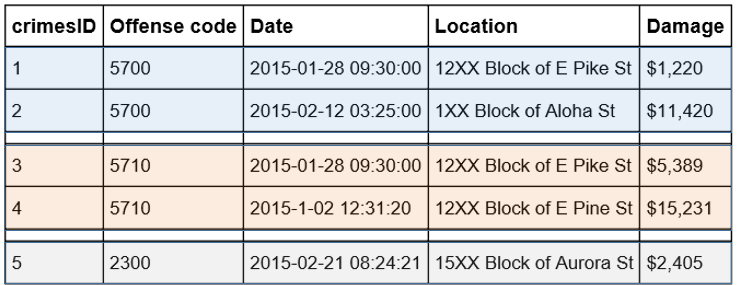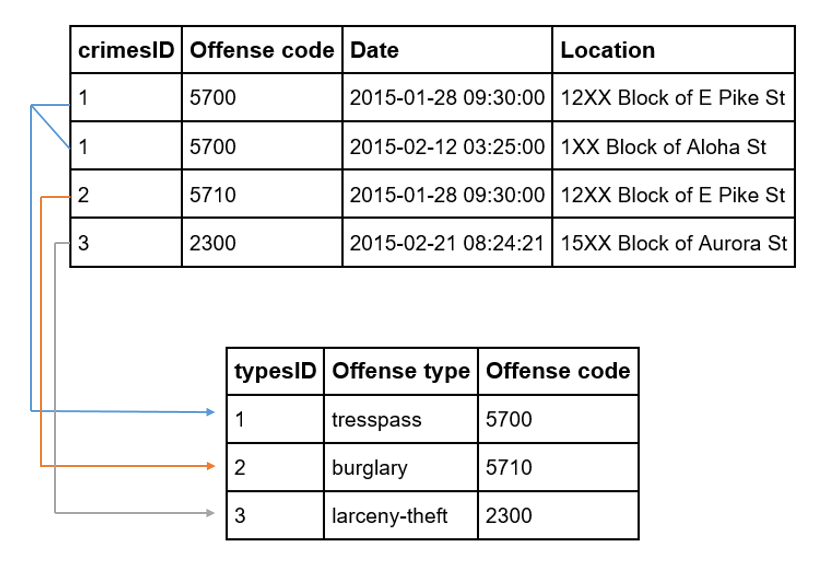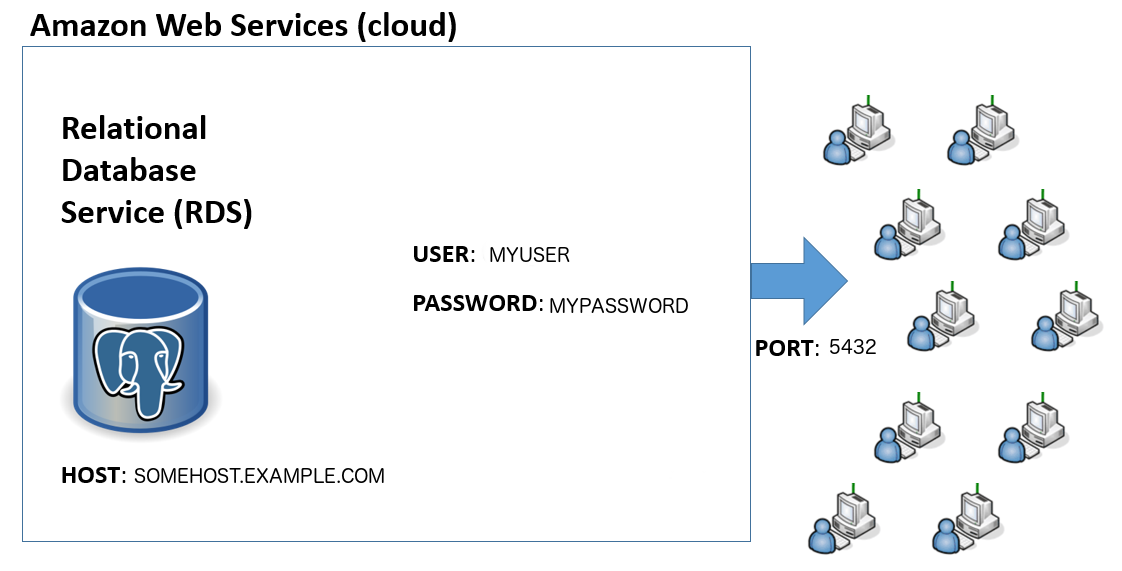Overview
Teaching: 15 min Exercises: 0 minQuestions
What is a database?
How are data structured within a database?
What are the advantages of working with data in a database?
Objectives
Learn the fundamentals of the relational data model
Begin to identify in which cases it makes sense to put your data in a database
Learn a bit of Structured Query Language (SQL)
Learn about some of the specific rules of how to structure a database
What is a database?
- a database is a software system for capturing, storing and analyzing data.
- nearly all databases use the relational data model in which information is structured in row and column format:

Motivation for using a database
- fast searching
- powerful methods for performing analysis on groups of data
- capability of joining information between datasets
- data types have unique functionality (e.g. dates are not just integers but have methods related to year, month, day)
- centralized repository, minimizes duplication, controlled access across multiple users
- optional: geospatial encoding
The relational data model:
- there are many different flavors of databases but the most well developed is the relational data model
- each record has a unique identifier (primary key)
- data are manipulated using Structured Query Language (SQL):
Structured Query Language (SQL):
- standard language for relational databases
- across different databases the core syntax is similar but there are small differences in some function names
Creating a database table:
- before adding any data to a database it is necessary to create a table
- here is an example using some of the information from our sample crimes dataset:
CREATE TABLE seattlecrimesincidents
("crimesID" int,
"Offense type" character,
"Offense code" int,
"Date" timestamp,
"Location" character);
- this command creates an empty table:

Data Types
- all data in a column must be of the same data type
- this is required by SQL so that the database knows how to operate on the data in a consistent way
- here are a few common data types:
| Name | Aliases | Description |
|---|---|---|
| boolean | bool | logical Boolean (true/false) |
| character | char | fixed-length character string |
| date | calendar date (year, month, day) | |
| double precision | float8 | double precision floating-point number (8 bytes) |
| integer | int, int4 | signed four-byte integer |
| json | JSON data | |
| money | currency amount | |
| timestamp | date and time (no time zone) | |
| xml | XML data |
Populating the database records:
- here’s an example of how we can insert data into a database:
INSERT INTO seattlecrimeincidents VALUES
(1,'trespass', 5700,'2015-01-28 09:30:00','12XX Block of E Pike St'),
(2,'larceny-theft',2300, '2015-02-21 08:24:21','15XX Block of Aurora St');
- note that the order of the values insterted matches the order in which the column names were created
- here is what the table looks like now:
| crimesID | Offense type | Offense code | Date | Location |
|---|---|---|---|---|
| 1 | tresspass | 5700 | 2015-01-28 09:30:00 | 12XX Block of E Pike St |
| 2 | larceny-theft | 2300 | 2015-02-21 08:24:21 | 15XX Block of Aurora St |
Database rules:
All databases adhere to strict rules about how the data are structured
Normalization
- all row elements must contain a unique piece of information
- this normalization of your tables will minimize redundancy
- for example, suppose we tried to list two offenses at the same time, in the same row:
| crimesID | Offense type | Offense code | Date | Location |
|---|---|---|---|---|
| 1 | tresspass and burglary | 5700 and 5710 | 2015-01-28 09:30:00 | 12XX Block of E Pike St |
| 2 | larceny-theft | 2300 | 2015-02-21 08:24:21 | 15XX Block of Aurora St |
- this is incorrect because the database will have problems searching these columns
- the solution to this problem is simply to create another row:
| crimesID | Offense type | Offense code | Date | Location |
|---|---|---|---|---|
| 1 | tresspass | 5700 | 2015-01-28 09:30:00 | 12XX Block of E Pike St |
| 2 | burglary | 5710 | 2015-01-28 09:30:00 | 12XX Block of E Pike St |
| 3 | larceny-theft | 2300 | 2015-02-21 08:24:21 | 15XX Block of Aurora St |
NULL Values
- missing data are a common feature of many datasets
- many datasets encode missing data inconsistently (e.g. with “X” or -9999)
- in this example, the code for “tresspass” is not known so the data entry is “X”
| crimesID | Offense type | Offense code | Date | Location |
|---|---|---|---|---|
| 1 | tresspass | X | 2015-01-28 09:30:00 | 12XX Block of E Pike St |
| 2 | burglary | 5710 | 2015-01-28 09:30:00 | 12XX Block of E Pike St |
| 3 | larceny-theft | 2300 | 2015-02-21 08:24:21 | 15XX Block of Aurora St |
- to solve this, the relational databases introduced NULL values:
- NULL is a state representing a lack of a value
- NULL is not the same as zero!
- NULL values are ignored in SELECT statements
Selecting Data:
- one of the most common operations on a SQL table is to
SELECTdata - here we select based on a specific offense code:
SELECT "Offense type", "Offense code", "Date", "Location"
FROM seattlecrimeincidents
WHERE "Offense code" = 5700;
- note we are using a
WHEREclause to select specific rows
| crimesID | Offense type | Offense code | Date | Location |
|---|---|---|---|---|
| 1 | tresspass | 5700 | 2015-01-28 09:30:00 | 12XX Block of E Pike St |
-
this example shows how to use a comma separated list to select specific columns:
-
selecting data:
SELECT "Offense type", "Date"
FROM seattlecrimeincidents;
| Offense type | Date |
|---|---|
| tresspass | 2015-01-28 09:30:00 |
| larceny-theft | 2015-02-21 08:24:21 |
Functions
- databases have a wide range of functions that can operate on row elements
- one of the most common functions is to extract a subset of a date (e.g. year, hour) from a column with type = “timestamp”
SELECT "Date Reported", date_part('hour', "Date Reported")
FROM seattlecrimeincidents
LIMIT 5;
- Databases also have aggregate functions used on sets of data
- examples include
SUM(),MAX(),MIN(),AVG(),COUNT(),STDDEV()
Data Analysis:
- databases have powerful methods for analyzing data
- one of the most common tasks: applying statistics across groups
- to accomplish this we need to learn
- how to
GROUPsets of data - how to apply statistical functions to those groups
- how to
| crimesID | Offense code | Date | Location | Damage |
|---|---|---|---|---|
| 1 | 5700 | 2015-01-28 09:30:00 | 12XX Block of E Pike St | $1,220 |
| 1 | 5700 | 2015-02-12 03:25:00 | 1XX Block of Aloha St | $11,420 |
| 2 | 5710 | 2015-01-28 09:30:00 | 12XX Block of E Pike St | $5,389 |
| 2 | 5710 | 2015-1-02 12:31:20 | 12XX Block of E Pine St | $15,231 |
| 3 | 2300 | 2015-02-21 08:24:21 | 15XX Block of Aurora St | $2,405 |
- suppose we ask:
“What is the total damage that occurred for each offense type?”
- to answer this, first we need to
GROUPthe data by “Offense code”:

SELECT SUM("Damage")
FROM seattlecrimeincidents
GROUP BY "Offense code";
| Offense code | totalDamage |
|---|---|
| 5700 | $12,640 |
| 5710 | $20,620 |
| 2300 | $2,405 |
Column aliasing:
- often we want to rename newly generated columns:
SELECT "Date Reported", date_part('hour', "Date Reported") AS "reported hour"
FROM seattlecrimeincidents
LIMIT 5;
| Date Reported | reported hour |
|---|---|
| 2015-01-28 09:30:00 | 9.0 |
| 2015-01-28 11:05:00 | 11.0 |
| 2015-01-29 19:57:00 | 19.0 |
| 2015-01-28 15:17:00 | 15.0 |
| 2015-01-27 04:25:00 | 4.0 |
Joining Tables
- well designed databases distribute data across multiple tables, for efficiency
- then we can JOIN data between tables as needed

Database Implementation:
- there are many relational database software implementations:
- commercial: Oracle, Microsoft SQL Server, IBM DB2
- open source: MySQL, PostgreSQL
- regardless of the software:
- most databases are deployed on a server
- can deploy locally for testing
Database Interface:
- all databases are accessed via a connection string:
- hostname, port, user, password

Key Points
Databases offer a highly structured framework for storing and rapidly manipulating data
Setting up this structure takes some time
Advantages include the ability to investigate complex relationships between data using a simple query language